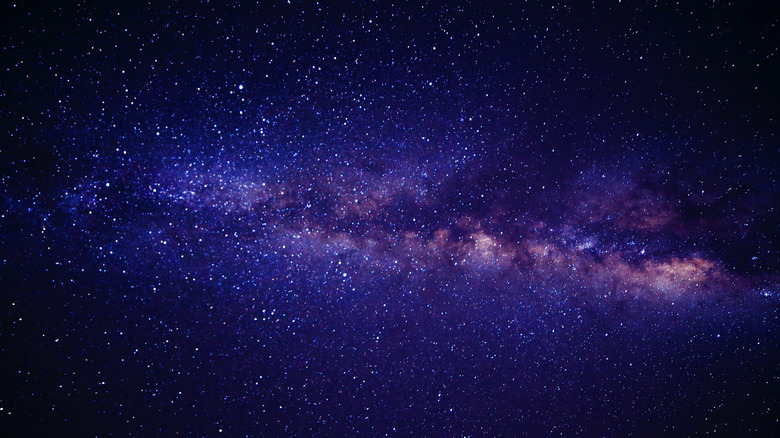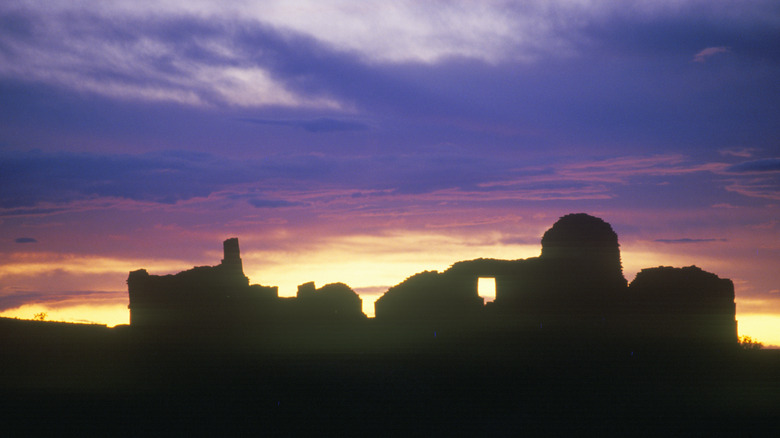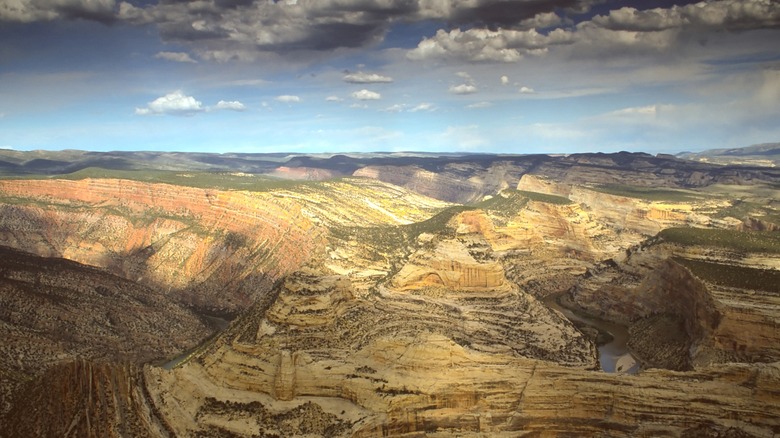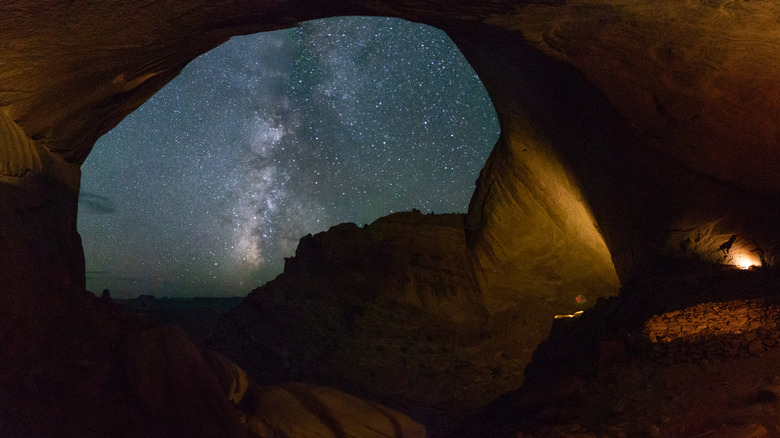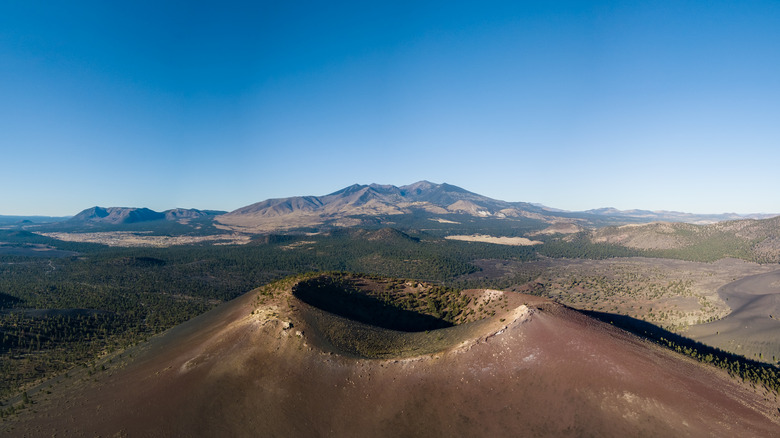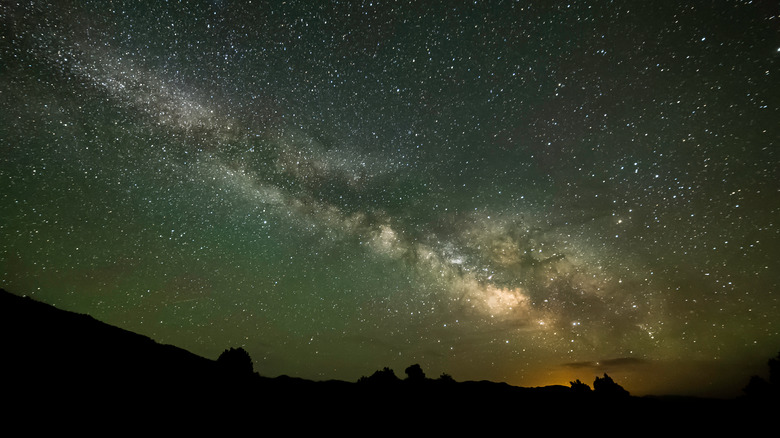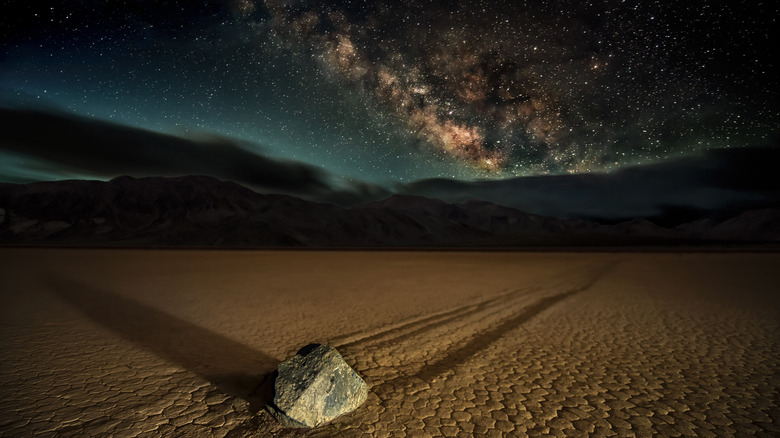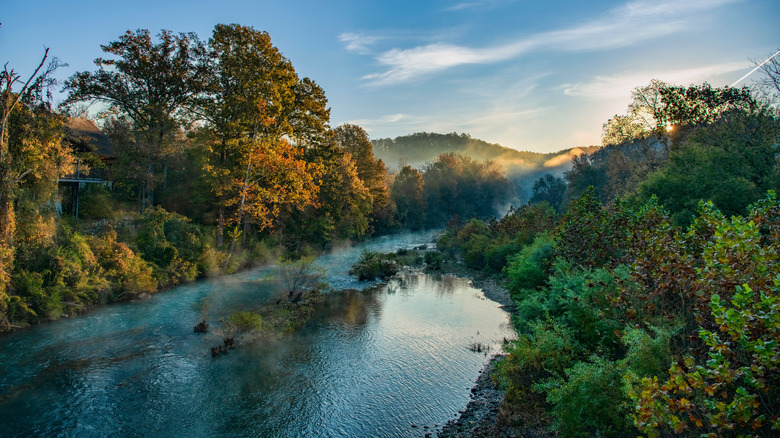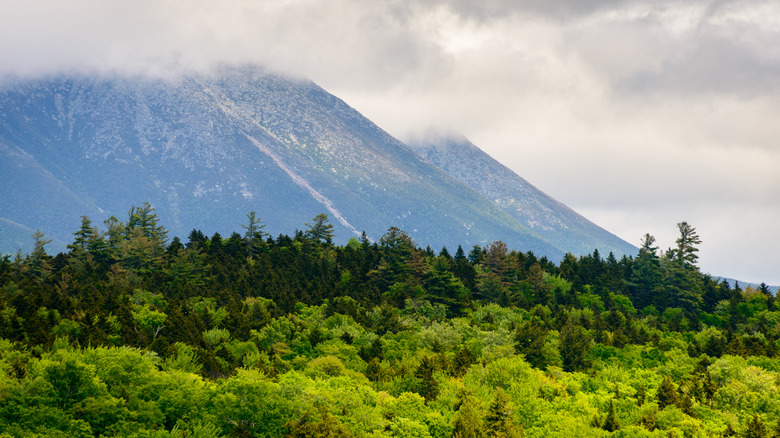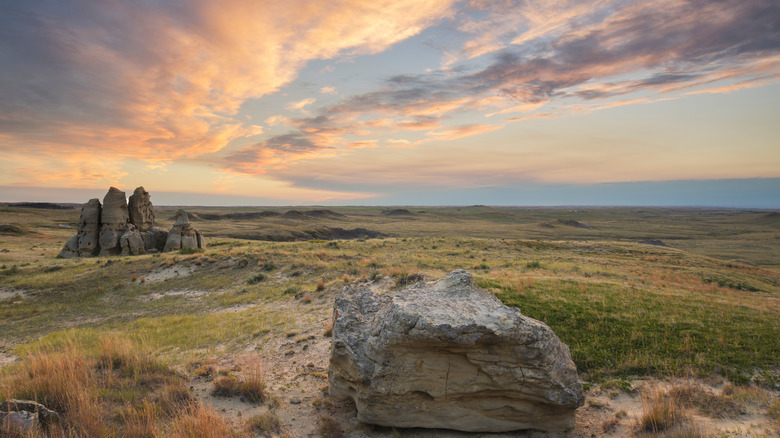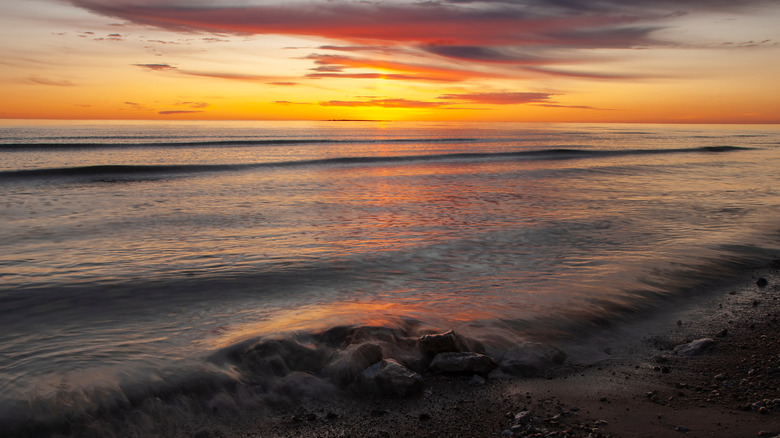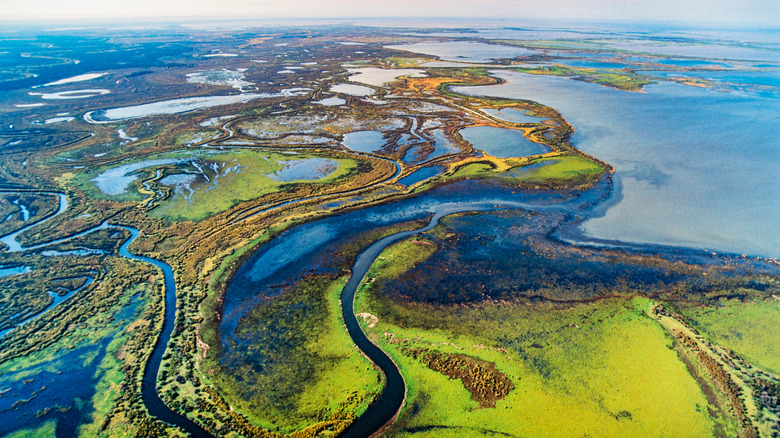These Are The Best Places To See The Stars In North America
Earth is totally lit. Figuratively, as the kids would say, and literally, as the general population would accurately quip. As the developing world continues to illuminate the atmosphere from below, the majesty of the night sky has become increasingly — hate to say it — dull. According to National Geographic, 99% of Americans and Europeans could not see the Milky Way in 2016. In fact, some folks have never seen the shimmering band of our own galaxy. When the Northridge Earthquake rattled through Southern California in 1994, the power outage led people to call their emergency centers about a weird sparkling cloud in the sky, per National Geographic. Oof.
Along with not knowing what your own galaxy looks like, imagine never seeing a sassy meteor sling its sparkle across the zenith, or the delicate rings of Saturn with a pair of binoculars. Dark skies are not only a fabulous, soul stirring display for humanity, but the majority of Earth's ecosystems depend on the umbra to thrive, per the International Dark Sky Association. When we visit the pitch-black places of North America, we're pretty much going back in time, both to a place where nocturnal species can live their best lives, and one that long ignited the imagination of our ancestors. These destinations across the continent will be your time machine.
Chaco Canyon, New Mexico
Deep within the New Mexico wilderness, an abandoned city more than 800 years old sprawls through the parched, windswept landscape of Chaco Canyon. The massive archeological treasure trove was established as a National Monument in 1907 by Teddy Roosevelt, with more than 2,500 prehistoric archeological sites and over 100,000 artifacts in need of protection, per National Park Service. Good call on that one, Ted!
Chaco Canyon has long been a sanctuary for starry nights. It hosts one of the most interesting ancient solar calendars discovered in the United States — the Sun Dagger, which is over 1,000 years old. The city also reveals how the Ancestral Puebloans were completely starry eyed, aligning their ceremonial spaces to the constellations and creating lasting artwork of interstellar events, per EarthSky. Further, researchers even think that the Ancestral Puebloans probably watched a slew of major astro-happenings take place, like the supernovas of 1006 and 1054, Halley's Comet in 1066, and a total solar eclipse in 1097.
Today, Chaco hosts an impressive Night Sky Program and an observatory that gives visitors a front-row seat to the final frontier, per NPS. Combining its 70-mile distance from the nearest sign of civilizations, along with nixing permanent lighting in the park, Chaco Canyon's night skies look just as they did thousands of years ago, and it is considered a Gold-tier level destination by the International Dark Sky Association.
Dinosaur National Monument
Splintering across Colorado and into Utah, Dinosaur National Monument is a geologic dreamscape decorated with gargantuan faults, narrow chasms, and monoliths seemingly stuck in mid-slide. Its dramatic landscape was formed with the help of the Green and Yampa Rivers, which have been slicing into the Earth's crust for eons. And if the name hasn't already given it away, the monument is also absolutely stuffed with dinosaur fossils. The area was sparsely explored before the 20th century, until a paleontologist dug up 350 tons of fossils in one of the most successful archeological findings of all time, per NPS.
"Dinosaur," as it's affectionately called by the locals, was designated as a Dark Sky Park in 2019. However, the monument has celebrated its skies thick with galactic glitter for decades with festivals and guided moonlight hikes, according to the International Dark Sky Association. According to NPS, you can ogle at up to 4,500 stars with the naked eye in Dinosaur National Monument. Compared to the 250 you might be able to see in nearby Denver, Colorado, that level of celestial realness is pretty impressive.
Canyonlands National Park
The Colorado Plateau has quite a few promising locations to offer, and this humongous network of canyons in the red rock desert is a downright must for star chasers. Utah's Canyonlands National Park is reminiscent of the Grand Canyon both for its endless escarpments of sunburnt sandstone, as well as the magnificence of its sheer size. Per Visit Utah, Canyonlands is the largest of Utah's "Mighty Five" national parks. So, if you're looking for a level of isolation that would probably make most people uncomfortable, this is the place in the Southwest to plan your escape from civilization. According to NPS, the 520 square miles of this Dark Sky Park is broken into four districts, all of which hold significant archeological sites and scenery that will leave your jaw dragging across the slickrock.
The Maze is the most remote district of the park, which is about 35 miles from the nearest town of Moab, and thus, it is the darkest of the districts. On a moonless night, the intergalactic world above is so crystal clear, star gazers can see the rings of Saturn with just a pair of binoculars, according to NPS. And if you're in a hot pursuit to catch the bands of the Milky Way, summer is the best time to go, according to the Space Tourism Guide.
The Sunset Crater Volcano
About 1,000 years ago, Arizona's youngest volcano had a pretty epic explosion. It shook the Earth for weeks, cracked it open with a 6-mile-long fissure, and proceeded to spew a "curtain of fire" up to 850 feet tall, according to NPS. The lava buried the evacuated villages of Native Americana as it spread out over 900 square miles, leaving it completely barren and riddled with basalt for centuries.
Today, the Sunset Crater Volcano is covered with looming ponderosa forests, and it is designated as one of three Flagstaff Area National Monuments for its historical and geological significance. But before its designation in 1930, a Hollywood film crew had chosen the volcano as the location where they would create a real life avalanche for a novel-inspired movie, according to the National Parks Conservation Association. The plan was to blow up part of the crater with dynamite, but the locals immediately petitioned Congress to protect the historical site from this frivolous scene. President Herbert Hoover, a total advocate for the Antiquities Act, happily obliged.
This volcano is just one of 600 in Northern Arizona's hot spot, which will likely have more eruptions (although probably not as catastrophic) in the future, according to the U.S Geological Survey. Surprisingly, the Sunset Crater Volcano isn't that remote for a Dark Sky Park, being only a 30 minute drive from Flagstaff. While camping isn't allowed on the volcano itself, stargazers can set up in close proximity to it.
The Massacre Rim Wilderness
According to the Bureau of Land Management, if you're looking for the one of the most pitch black places on Earth, head out into the middle of nowhere of Northern Nevada to the Massacre Rim Wilderness. This wilderness study area is a Dark Sky Sanctuary, meaning it's so remote that it has little to no threat of pesky light pollution. When it was designated in 2019, it became one of 15 Dark Sky Sanctuaries in the world. Per the International Dark Sky Association, only about 800 people live in the nearest valleys of this protected wilderness study area, keeping it primed for the cosmos to completely cloak the atmosphere.
So what makes the vistas of Massacre Rim so gosh darn splendid for stargazing anyway? Aside from the obvious prerequisite of being supremely secluded from civilization, this bespangled area is nestled in the high desert. The combination of its higher elevation (between 5,520 to 6,780 feet) and dry air not only puts the eyeballs closer to the sky, but the palpable lack of humidity here keeps the air crisp and clear, per Desert Museum. July is the prime time to visit here as the Perseids meteor shower starts falling, and the Sagittarius and Scorpio constellations headline the zenith, per BLM.
Death Valley
Between the mega metros of Los Angeles and Las Vegas, the hottest place on Earth also boasts some of the darkest skies in the United States. Death Valley was the third designated International Dark Sky Park in the country, and is considered a Gold Tier destination to space out on ... well, outer space, per NPS. The park has strived to keep light pollution on the down low for decades, using softer lighting and pointing bulbs downward to reduce glare, according to National Geographic.
However, the electric displays that keep Sin City bedazzled all day and all night have started encroaching on Death Valley. Artificial light can travel up to 217 miles, and the national park is about 130 miles away from Las Vegas, per National Geographic. Still, according to NPS, stargazers can retreat from the city glow to the Harmony Borax Works, Mesquite Flat Sand Dunes, Badwater Basin, and the Ubehebe Crater. The best time to catch as many twinkles as possible in Death Valley is February, which is also during its Dark Sky Festival.
The Buffalo National River
The Buffalo is America's first national river, cutting through the rugged and lush boondocks of northern Arkansas. The free-flowing tributary was awarded its Dark Sky Park designation in 2019, and it's got 135 miles of protected wilderness to meander through. And though one doesn't have to visit the Buffalo National River with a boat to explore it, it will certainly give you an edge on the sites to see along the drift.
Per NPS, this river boasts more than 500 caves, carved out of soft, 300-million-year-old limestone of areas like the Boone formation. Inevitably, plenty of caves means plenty of critters — like bats. Lots and lots of bats. With 12 species of microbats fluttering in and out of the karsts along the river, these light-shy mammals have benefited from the profound darkness along the Buffalo River, and are a huge contributor to its rich biodiversity, per NPS.
Katahdin Woods and Waters
These dreamy woodlands are nestled in one of the most northern areas of the United States. They've certainly earned bragging rights for having some of the darkest skies this side of the Mississippi, according to NPS. In its 137 square miles, the area has no commercial power sources or electric lights. It also turns out that a portion of the land was donated by a foundation created by the founder of Burt's Bees, Roxanne Quimby, to become the national monument it is today, per the Natural Resources Council of Maine. Quimby acquired humongous plots of this lucrative forest by using a portion of the profits from Burt's beloved beeswax (which came fruition in the Maine wilderness to begin with) to protect it for the enjoyment of the public, according to The Maine Mag.
According to the Natural Resources Council of Maine, the Katahdin Woods and Water National Monument was the first Dark Sky Sanctuary on the eastern seaboard, a coast riddled with so many cities that their lights can be seen from outer space. The remote nature of the Katahdin Woods and Waters beckon visitors to be prepared for some quality isolation. Per Visit Maine, cell service is totally null and GPS is most likely required, along with a vehicle equipped to navigate the rubble-covered roads leading to the glory of indubitably dark skies.
Medicine Rocks
These strange and beautiful geologic formations rising from the remote prairie of eastern Montana have continued to serve as a place of profound significance for thousands of years. The Mandan and Hidatsa Native American tribes from the area continue to visit Medicine Rocks multiple times a year for spiritual ceremonies, per the State Historical Society of North Dakota. Medicine Rocks also boasts an impressive gallery of ancient rock art, where abstract scenes share stories of epic battles while others show grizzly bears strolling next to turtles.
Explorers Lewis and Clark witnessed an Indigenous ceremony held near this site in 1805 during their expedition of the uncharted West. Clark recounted in his journal that the tribes who visited these decorated monoliths believed they held supernatural powers, including prophecies written in the stone that came straight from the spirits of the universe, according to the State Historical Society of North Dakota. Carrying on at least 2,000 years of tradition, it is a common practice for Indigenous peoples to sprinkle tobacco as an offering at this isolated, archaeological wonderland.
The historical landmark is at least 100 miles from any signs of civilization, leaving the cosmos completely reminiscent of how it was displayed to people thousands of years ago, per Sunset. This has allowed it to exceed the requirements of making it a Dark Sky Park as well as a Dark Sky Sanctuary. That said, Medicine Rocks is known to be one the darkest places on Earth, and possibly one of the most precious in North America.
Newport State Park
This thriving forest lines the coast of Lake Michigan, and is a primo spot to photograph the righteous luminescence of the Milky Way. Newport State Park was named a Dark Sky Park in 2017 for its little to nonexistent development both inside and near the wilderness area. According to the Newport Wilderness Society, the area was logged like nobody's business for the growing cities of Milwaukee and Chicago, and the forest was pretty sparse by the early 1900s. In 1915, a Chicago jeweler wandered to the end of the petite peninsula and purchased the over-used land where the park is today. His name was Ferdinand Hotz, a German immigrant who believed that nature deserved to be left as it was. His kids were evidently in agreement, and sold nearly 1,500 acres of their property to the state of Wisconsin to protect this coastal paradise in 1967, per the Newport Wilderness Society.
To sleep under the thousands of stars that emerge over Lake Michigan here, visitors have to take a short backpacking trip into the park to designated campsites, per Travel Wisconsin. In fall, Newport State Park hosts an event for viewing the Perseids Meteor Shower, which is a pretty sweet treat in this region given that this astronomical phenomenon can usually only be seen in the West!
Wood Buffalo National Park
If Canadians have been feeling left out so far, fret not, because Wood Buffalo National Park is the largest Dark Sky Preserve in the world, according to the Government of Canada. Booyah! It also sets the record for hosting the largest herd of the endangered wood bison on Earth (hence the name), per UNESCO. The preserve was designated by the Royal Astronomical Society in 2013, and it is so far up north in Alberta, you just might run into Santa, although the chances are probably pretty slim since the preserve is bigger than Switzerland.
Since Wood Buffalo is so remote, as well as geographically situated to require the biggest and baddest parka one can find, the grasslands and forests of Buffalo Wood have remained extraordinarily pristine. UNESCO has deemed the park with having "Outstanding Universal Value," meaning it is legally protected and highly restricted from exploitation of its natural resources. This is also the only deep dark place on the list that can also display the Northern Lights from time to time. Take that, other parks too low to glow! Each year, the Dark Sky Festival takes place here in August when this stretch of latitude actually starts to get dark skies once again.
